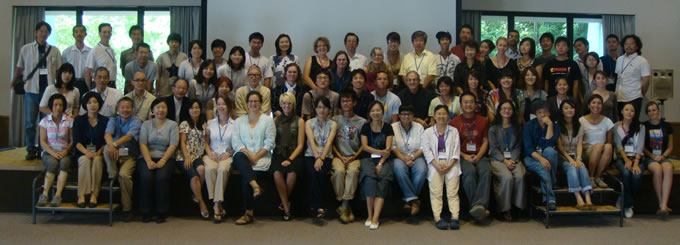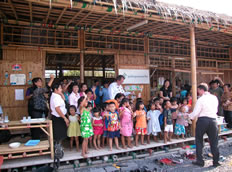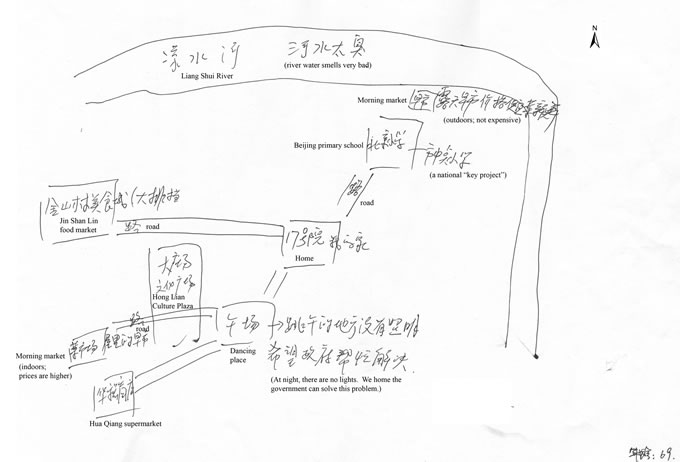RIM: Newsletter of the Pacific Rim Community Design Network
Issue 1 | Issue 2 | Issue 3 | Issue 4, Autumn 2010| Issue 5 | Issue 6 | Issue 7
The Pacific Community Design Network is thankful to Prof. Mayumi Hayash, Leiko Toyoda, volunteers and the faculty and staff at the Awaji Landscape Planning and Horticulture Academy, University of Hyogo for successfully hosting its 7th conference. The conference events included a day of community festivals and keynotes speech, a day of presentations in parallel sessions that feature recent work in community design in the Pacific Rim, followed by tours of disaster recovery efforts in Kobe and a taste of slow food and slow life (but quick tour stops) on the scenic Awajishima. Conference participants came from China, Hong Kong, Indonesia, Japan, S. Korea, Sri Lanka, Taiwan, and the United States.

Centre for Architecture and Human Rights

Graeme Bristol, Exec. Dir. of the Centre for Architecture and Human Rights, is working on a book titled "Architecture and Human Rights." In addition to that he has been working on a paper for an upcoming special issue of Building Research & Information. This is on 'Stakeholders in informal settlements' and will be focused on research in Bangkok and Phnom Penh over the last three years on issues of development-induced displacement (another World Bank euphemism). Over the last 2 years Graeme has also been working on a number of issues concerning migrant construction labourers in SE Asia, particularly as it relates to their children. Related to that, the bamboo school KMUTT architecture students and my Centre put up last year now has a student body of some 70 children from local construction camps and the broader community in Samut Prakan (a suburb of Bangkok). They celebrated their first year of operation this past July 1st. (See photo)
Community Design with Biodiversity
Mayumi Hayashi, Associate Professor at University of Hyogo, had just published a book. The title is "Community design with Biodiversity." Mayumi was the coordinator for the 7th Conference of the Pacific Rim Community Design Network in Awaji, which was very successful. She and her team were very glad that many people had participated in the conference.
Fieldwork in Beijing

Caroline Chen, PhD candidate, University of California at Berkeley, spent five months in Beijing conducting follow-up interviews with aging yangge dancers whom she met in 2007. In between her visits, Beijing hosted the Olympic games, an event that was preceded by accelerated urban change. From the longitudinal data collected in 2007 and 2010, she continues to ask the question: how do globalizing forces affect the everyday life of elderly yangge dancers, and conversely, how do they choose to respond or adapt to these spatial changes from the top? Also in Beijing, she fulfilled her Roslyn Lindheim grant in public health. She collected daily routines, cognitive maps, as well as their daily paths from one group of dancers in the Xuanwu district of Beijing (see figure). Lastly, she is currently applying to teaching and research jobs in schools of landscape architecture, planning and geography in the US for 2011.
User-initiated Open Space
Laura Lawson has recently taken the position as Chair of the Department of Landscape Architecture at Rutgers, The State University of New Jersey. Her work continues in user-initiated open space, with particular focus on community gardens, urban agriculture, and park revitalization in low-income urban communities in the United States.
Public Design
Kin Wai Michael Siu is Professor & Lab Leader of Public Design Lab at the Hong Kong Polytechnic University. His experience in public design focuses on street furniture and public facilities. In collaboration with blind communities, he is now conducting a research project to improve the public toilet environment for the visually impaired persons. He is also leading a team of designers to review and design open space for small communities in densely populated areas. His other project is about how to enhance recycling practice by household and community participation in densely populated housing estates. He just finished a street bollard design project (FlexiBOL), which enables a flexible implementation and management of bollard system installed in different types of streets.
Personal Notes
Jin-Yung Wu is a licensed architect and currently a doctoral student at the Graduate Institute of Building and Planning, National Taiwan University where he also teaches a design course.
Teruhiko Yoshimura is Associate Professor at Nihon Fukushi University whose research areas are Machi-zukuri (community development, community-based planning, community design), Urban Planning, and International Development. In particular, he focuses on "social space" for a dialogue and deliberation, which encourages interaction, reflection, and transformation among stakeholders/actors in promoting Machi-zukuri. In this line, I wrote several papers. Before moving to the Nihon Fukushi University, he worked for United Nations Centre for Regional Development (UNCRD) from 1999 to 2006.
Bristol, Graeme. Architecture and Human Rights, in Cushman, Thomas (ed.) Handbook of Human Rights, Routledge (forthcoming).
Bristol, Graeme. Rendered Invisible: Urban Planning, Cultural Heritage, and Human Rights, in Logan, W., Nic Craith, M., and Langfield, M. (eds.) Cultural Diversity, Heritage and Human Rights, Routledge, 2010.
Bristol, Graeme. Surviving the Second Tsunami: land rights in the face of buffer zones, land grabs, and development, in Lizarralde, G., Davidson, C., and Johnson, C. (eds.), Rebuilding after disasters: From emergency to sustainability, Taylor & Francis, 2010.
Chen, Caroline. “Dancing in the Streets of Beijing: Improvised Uses Within the Urban System.” In Insurgent Public Space: Guerrilla Urbanism and the Remaking of Contemporary Cities, edited by Jeffrey Hou, 21-35. 1st ed. Routledge, 2010.
Hayashi, Mayumi. "Community design with Biodiversity", Kyoto, Japan, 2010.
Hou, Jeffrey. Citizen Design: Participation and Beyond. In Banerjee, Tridib and Anastasia Loukaitou-Sideris (eds.), Urban Design: Roots, Influences and Trends, the Routledge Companion to Urban Design. Oxon, UK: Routledge, 2010.
Lawson, Laura. “When the Going Gets Tough, the Tough Get Gardening: The American Victory Garden Campaign of World War II.” Greening the Red Zone: Vulnerability, Resilience, and Community Greening. Edited by Keith G. Tidball and Marianne E. Krasny. Amsterdam: Springer Press (anticipated December 2010).
Lawson, Laura, Lisa Spanierman, V.Paul Poteat, Amanda Beer. “Is it Professional or Personal? Engagement, Race, and Reflection in the East St. Louis Community-based Design Studio.” In Erasing Boundaries – Supporting Communities. Edited by Cheryl Doble, Paula Horrigan, and Tom Angotti. New Village Press, 2011 (planned).
Lawson, Laura and Janni Sorensen. “When Overwhelming Effort Meets Underwhelming Prospects: Sustaining Community Open Space Activism in East St. Louis.” Insurgent Public Space. Edited by Jeff Hou. Oxon, UK: Routledge, 2010.